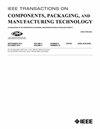Automatic Test and Array Crosstalk Suppression Scheme for 3D-ICs With Inductively Coupled Interconnections
IF 2.3
3区 工程技术
Q2 ENGINEERING, ELECTRICAL & ELECTRONIC
IEEE Transactions on Components, Packaging and Manufacturing Technology
Pub Date : 2025-02-19
DOI:10.1109/TCPMT.2025.3543763
引用次数: 0
Abstract
Inductively coupled interconnection (ICI) is a wireless interchip interconnect technology for 3D-ICs, which offers cost savings and enhanced flexibility compared to through-silicon via (TSV). However, ICI presents unique key challenges, including high power consumption, reliability issues, and the complexity of wire bonding during the stacking process. To overcome these challenges, we propose a new packaging process, chip edge connection (CEC), and self-sorting and power-tuning circuits. We also propose an array crosstalk suppression (ACS) strategy. We showed the designed chip in a 180-nm CMOS process. The results show that the CEC process can establish a conductive channel at the chip edge. The self-sorting circuit can provide chip IDs without wire bonding. For four-layer stacked chips with a 50% single-layer misalignment, the power-tuning circuit reduces power consumption by 20.98%. Furthermore, the ACS scheme reduces the bit error rate (BER) to between求助全文
约1分钟内获得全文
求助全文
来源期刊

IEEE Transactions on Components, Packaging and Manufacturing Technology
ENGINEERING, MANUFACTURING-ENGINEERING, ELECTRICAL & ELECTRONIC
CiteScore
4.70
自引率
13.60%
发文量
203
审稿时长
3 months
期刊介绍:
IEEE Transactions on Components, Packaging, and Manufacturing Technology publishes research and application articles on modeling, design, building blocks, technical infrastructure, and analysis underpinning electronic, photonic and MEMS packaging, in addition to new developments in passive components, electrical contacts and connectors, thermal management, and device reliability; as well as the manufacture of electronics parts and assemblies, with broad coverage of design, factory modeling, assembly methods, quality, product robustness, and design-for-environment.
 求助内容:
求助内容: 应助结果提醒方式:
应助结果提醒方式:


